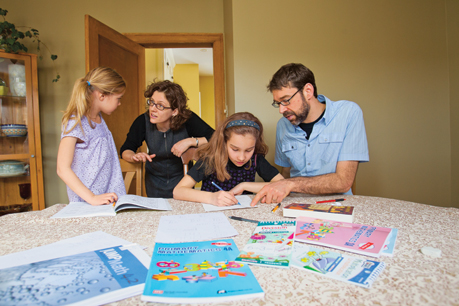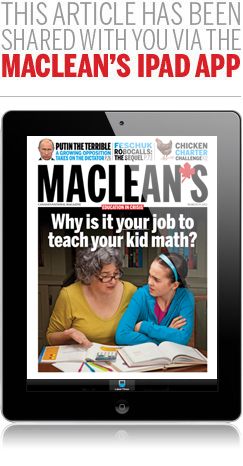
When mother of two Anna Stokke began digging into the elementary school math curriculum last year, she was flabbergasted by what she found. Instead of teaching the standard methods of arithmetic, the emphasis had shifted to a wide range of alternative methods, such as using grids, blocks, or strips of paper to multiply. Stokke is a professor of math at the University of Winnipeg, but even she found the methods confusing. “It was shocking,” she recalls. “We’re talking about adding, subtracting, multiplying and dividing. It shouldn’t be so overly complicated that even parents can’t understand it. It’s absolutely ridiculous.”
Stokke began speaking out and soon parents from all over Canada were sending her similar stories of discontent: kids who couldn’t do their homework without help, parents who couldn’t make heads or tails of the assignments so they were hiring tutors, or spending hours looking up math sites on the Internet because the textbooks are so vague. She heard from teachers who felt pressured not to teach the traditional methods. Stokke and her husband, Ross—who is also a math professor at the University of Winnipeg—started up a biweekly math club for their daughter and 11 of her friends to pick up the educational slack. Out of concern for math education in general, Stokke, along with three colleagues, also co-founded the Western Initiative for Strengthening Education in Math (WISE Math), a coalition lobbying to improve K-12 math education. Parents (and teachers) from all over Canada have flooded their online petition with support. “I don’t have a problem with alternate strategies,” Stokke says. “But I fear they’re learning so many, that in the end they’re not mastering any.”
It was never supposed to be this way. Changes in the curriculum—which have rolled out cumulatively over the past decade and intensified in recent years—had sounded so promising: instead of stifling them with rote memorization and rigid methods, children are to use their own learning style to explore mathematical knowledge and conceptualize innovative solutions to complex problems, preparing them for an ever-changing tech-based economy. But the execution of this vision hasn’t been so idealistic. Instead of building a generation of math whizzes, it’s creating a Tower of Babel, where teachers can’t understand textbooks, students can’t understand teachers, and parents and children have no idea what the other is talking about. The confusion, some critics say, lays the groundwork for innumeracy that sticks with students through the grades, into post-secondary school and out into the workforce—this week business leaders reported that a growing chunk of Canadian kids simply don’t have what it takes to fill skilled positions.
To sort out the discord, some boards are hiring cadres of costly numeracy consultants to facilitate workshops for families and teachers, and developing online tools for parents to access. In many districts, families are left to grapple with the mess themselves. Either way, more parents are starting to speak out about the increasing amount of time, money and stress required to teach their kids what they should be able to master at school. “Kids spend six hours a day there—I think the schools should be able to teach math to children themselves,” says Stokke. “It’s completely wrong-headed. And the moment you say parents should play a significant role in public education, you have a two-tiered system.”
This month, in Hamilton, the Catholic school board is launching one of the more intensive initiatives to support parents—SuccessMaker, an online math program intended for the classroom, redirected for home use. Consisting of animated games and word problems, for the program to be effective it requires that parents commit 20 minutes a night, for a minimum of four nights a week, over a span of eight weeks. “We recognized that parents were having difficulty supporting their kids, so we wanted to give them this tool,” says Sandie Pizzuti, assistant superintendent of academic programs and services at the Hamilton-Wentworth Catholic District School Board. The flyer marketing the initiative uses language that goes directly to the core of parental fears: “Concerned about your child’s math scores? Does your child say he or she hates math? Finding it difficult to help with math homework? Wish you had the time or money to have your child tutored in math?” So far, 200 parents have signed up for the information session and they anticipate they’ll register about 500 parents; the ministry is covering the initial $12,500 in licensing fees.
Spending 20 minutes on math would qualify as a really great night for Jane Snider, a Saskatoon mother who asked to use a pseudonym for her daughter’s sake. When her daughter entered Grade 7, she began asking for help with homework. Snider tried to step in, but was blindsided by the methods they were supposed to employ, such as using graph paper to show how you can divide fractions and strips of paper to demonstrate ways to multiply them. “I never expected to run into problems at this grade level, and I knew I was making a mess of it,” says Snider, so she turned things over to her husband, an engineer. Accustomed to solving equations with formulas, her husband was spending up to two hours after work learning the new strategies and terminology himself, then teaching them to his daughter. There were times, says Snider, when he couldn’t understand the assignment at all. “It just became a blur of stress and frustration,” she says, adding that her daughter has lost all confidence with math and now professes to hate it. “We’ve had to spend so many nights dealing with this mess when we could be doing other things. It makes me so angry.”
Giving parents a better sense of the subject is one reason more schools are offering Math Nights. The theme of the workshops can vary, but in some cases parents are taught the same math strategies as their children. But with only an hour, one Toronto mother who attended a Math Night at her Grade 3 son’s school left confused. “But I’m glad I went—at least now I know how not to help my son,” she says, explaining that she was told that stacking two-digit numbers and carrying the one isn’t a good method for addition because kids don’t understand what it means to carry the one, that they’re really adding 10. Instead she learned alternate methods that yielded deep understanding, which the parents were told is more important than arriving at the correct answer. “But that seems wrong. Why does it matter so much for someone to always realize they’re adding 10? You get the right answer, and I do think that’s important.”
As one of the designers of the math curriculum for the western provinces, Debbie Duvall now works as a math consultant for the Elk Island public school district near Edmonton, where she gives workshops to parents. If a student can’t remember what 9 x 6 is, she says, they’re lost. But with a deeper understanding of multiplication, students realize they can multiply 10 by 6—an easier calculation—and subtract 6 to arrive at the answer. “We want to provide options for kids,” says Duvall, adding that at least one parent comes up to her after her workshops to say they wished they were taught this way. Taking into account all learners’ styles and capabilities is another big part of the approach. Back in Hamilton, numeracy consultant Kerry Dwyer-Mitchell recently divided a Grade 4 class into groups to teach multiplication through a pizza game (how many pieces are needed if 27 kids want three slices each?). Each group, she says, brainstormed a different strategy, such as repeated addition, adding partial products, or using a manipulative, like Base Ten Blocks. “Traditionally, you’d get your algorithm and you would just do it,” says Dwyer-Mitchell. “But they’re free to use whatever works best for them.”
Yet it’s that very freedom that, some say, is at the root of much of the confusion. “They’re really creative—but they don’t know what to do with it,” says Kim Langen, CEO and co-founder of the after-school math enrichment program Spirit of Math, based in Toronto. “The rigour of the procedure is being lost and the bar is getting set far too low.” While students need a minimum B+ to apply for Spirit of Math, Langen says that even these achievers can possess a worrying level of innumeracy—Grade 5 students who don’t know multiplication facts, have never encountered division, and just look at you blankly when you ask them what 23 + 7 is. In order to build students’ math facts, the first 10 minutes of the 90-minute session is dedicated to drills—then, explains Langen, because they’re not bogged down on simple calculations, they can handle the high-level conceptual work. “We had one vice-principal who saw the incredible difference drills made,” she says. “But he said, ‘I can’t do drills—the board won’t let me.”
And it’s not just students struggling, says Langen. When a parent came to her in tears because she couldn’t help her daughter who was struggling with math, Langen met with the teacher. At the meeting, the teacher sought Langen’s advice—she couldn’t get her students to understand metric conversions, in this case, converting 110 cm into metres. She showed Langen the blackboard filled with an elaborate matrix that neither adult really understood. Langen reached for a metre stick. “I told her she could use this to show there are 100 centimetres in one metre, and she just lit up.” Though she was taken aback by the encounter, Langen is quick to add that the teacher was bright, just uncomfortable with math—and this highly conceptual approach is often toxic for teachers without a solid grounding in math. “It’s so overcomplicated now. We use the old-fashioned methods. They’re fast, they work and it’s part of the reason parents come to us.” Nathalie Foy of Toronto has enrolled her Grade 5 son in the program. “I wish I didn’t have to supplement their education,” says Foy, “For one, it’s expensive. But this is a safety net—and now he knows his math facts cold.” At more than $1,800 per school year, it’s a pricey measure, but with more than 30 per cent of Canadians supplementing their children’s education, it’s one that more parents are investing in, especially as their kids move up the grades.
Christian Mihaila is a Grade 6 teacher who also works for Vancouver-based Academic Advantage, tutoring Grades 9 to 11 math. He says that a different set of problems can arise when students make the leap into high school math. From kindergarten to Grade 8, students become accustomed to using visual methods like grids and physical manipulatives like blocks to solve problems. When they hit high school, it’s suddenly more abstract, more pencil and paper, more . . . old school. But by then, the math has become too advanced for most parents to effectively help with and they either have to hire a tutor or drop their kids down to an easier stream. Or hope the school’s no-fail policy will continue to sail them through the grades and into university, where professors from coast to coast are vociferously complaining that first-year students are woefully unprepared in math. WISE Math co-founder Robert Craigen at the University of Manitoba was appalled to discover that two of his students had never learned long division, a necessary skill for his course. “Math is a universal language, but our kids aren’t learning how to speak it,” he says.
Back in Winnipeg, this domino effect is one of Anna Stokke’s biggest concerns. If they don’t know their math facts, she says, they won’t be able to do fractions, which means they won’t be able to handle algebra, which means calculus is out, which means they can’t be engineers, doctors, pharmacists, economists, programmers, or any discipline that requires math, including skilled tradeswork. But one thing they can become? Teachers, who can go through the system with minimal math training and arrive in class expected to inspire children to create and conceptualize their own mathematical knowledge—and relying on a new set of parents to fill the gap. “This is a never-ending cycle of innumeracy,” says Stokke. “And we have an obligation to speak up for the kids.”

